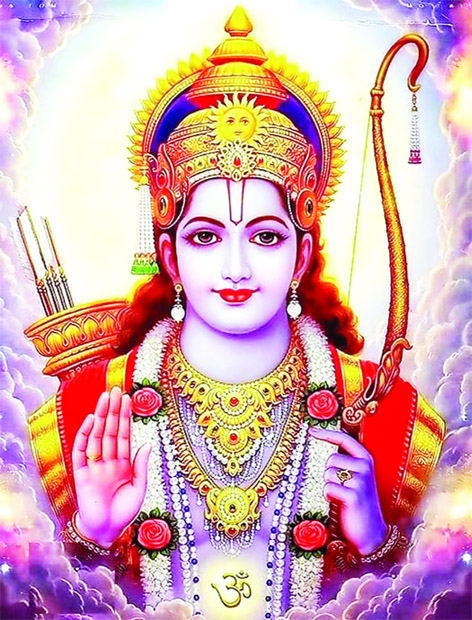Hemant Dharmat
Legends abound in various regions of India and Southeast Asia and references can be traced in all the major religions of the world about the Ramayana epic. And there is no single entity that unites the various communities of India more than the holy name of Bhagwan Shri Ram.
As per the oceanography research, the 48 km long Ramsetu connecting Rameswaram in Tamil Nadu with Mannar in Sri Lanka is made of 7000 years old natural limestone shoals with 4000 years old sandbar. This implies that that the boulders were transported to this site and sandbars were later formed around the rocks. As per Ramanathaswamy Temple records, the bridge was largely walkable before it was permanently submerged by a devastating cyclone in 1480 AD. The geological research broadly tallies with NASA’s findings on Ramsetu. When the position of planets and stars recorded by Mahrishi Valmiki at the time of Lord Ram’s birth was loaded into NASA’s planetary software, the results revealed the date of birth of Lord Ram as noon-time of 10 January, 5,114 BC (7,137 years back).
The ancient Ram bridge mentioned as Set Bandhai in Ibn Khordadbeh’s book of Roads and Kingdoms was known as Adam’s bridge in Mideast and the West. According to Abrahmic mythology Adam, the first human being landed upon a peak in Srilanka after his expulsion from the Garden of Eden – the biblical Paradise. Interestingly a hill feature in the island nation bears remarkable resemblance to Lord Hanuman in reclining position. Besides the word “Human” also bears similarity to the name of Hindu God Hanuman. Adam is believed to have reached India through this bridge from Srilankan soil.
Some Muslim intellectuals have begun to recognise Lord Ram as Imam-e-Hind. Famous Urdu poet Iqbal was the first to describe Him as such. Books of several other religions are replete with legends woven around the story of Ramayana. The pious word of Ram finds mention 2533 times in SRI GURU GRANTH SAHIB. In Sikh religion Ram is considered as Akal Purukh – one beyond time. Ram is described in the Jain scriptures as eighth Balabhadra among 63 illustrious figures. The Jain text is at variance with the Hindu epic, in that Ravana is described as having been slain by Lakshmana. In Buddhism Ram is considered Pratyeka Buddha and manifestation of the Buddha Mind. Legends about Ram found in the Budhist texts describe him as Pauma or Padma with details, varying significantly from the Hindu version.
The legend of Sri Ramchandra, the hero of Valmiki Ramayana and God of Tulsidas’s Ram Charitmanas had been popular far beyond the Indian subcontinent. Ramayan is part of the official history of the government of Srilanka. In Myanmar, Ramayan is called Yamayna, Lord Ram as Yama and Sita as Me Thida. Ayudhya pronounced as Ayuthaya in Thai language was the ancient name of Thailand. The national epic of Cambodia is Ramakien implying “Ram-keerti” viz. the glory of Lord Ram. There are several regional versions of the Ramayana in Japan. It is part of the lndonesian culture and heritage. The story in Malaysian Ramayan known as “Hikayat Seri Rama” tallies entirely with that of the Indian epic. “Maharadia Lawana” is the Filipino version of Ramayana. Carvings of Shri Ram and Lord Hanuman were discovered in Kurdistan, Iraq. The title of the Egyptian King ‘Ramses’ sounds similar to Ram, while Ramallah is a Palestinian city in the West Bank. Wall paintings of Italian buildings of the 7th millenium BC depict scenes from the Ramayana such as several people with tails, two men walking with bow and arrows in their hands accompanied by a woman with black hair and long braids in their midst. Interestingly, Ravana’s name bears uncanny similarity with the Italian city of Ravenna and Rome appears to have derived its name from Ram.
During his ‘vanvaas’ Prince Ram accompanied by his wife Sita and brother Lakshmana undertook barefoot journey through the jungles of Uttar Pradesh, Chhattisgarh, Madhya Pradesh, Odisha, Karnataka, Telangana, Andhra Pradesh Maharashtra and Tamil Nadu before invading Srilanka. The tell-tale marks of Lord Ram’s visit to the places mentioned in the epic are visible to this day.
The nation is awaiting with bated breath the inauguration of the newly built magnificient Ram Janambhoomi Mandir on January 22 at Ayudhaya which has been given a majestic look. It’s in this city that the epic begins. As per popular folklore consequent to their 14 year exile Ram, Sita, and Lakshman crossed the holy Ganga. At Prayagraj they visited sage Bharadwaj’s Ashram before proceeding to neighbouring Chitrakoot, where they spent several years of ‘vanvas’.
Sita, the devoted wife of Lord Ram was abducted by demon King Ravan at Panchvati located at Nashik. Legend has it that Lakshman had chopped off Sharupnakha’s nose at Panchvati whereafter it came to be known as Nashik (Nasika – nose). It was at this very place that Shabari fed partially eaten berries to Lord Ram. As per the legend Lord Ram gave salvation to Jatayu at Lepakshi in Andhra Pradesh when He uttered the words: “Rise, O bird” – ‘Le Pakshi’ in Telegu. He met Hanuman at Kishkinda, the citadal of Bali and Sugriv located along Tungabhadra river near Hampi and organised Vanarsena to invade Srilanka.
The echoes of the folklore interwoven around the lead story of Ramayana continue to reverberate to this day at all places associated with Lord Ram’s sojourn from Ayodhya to Rameshwaram. And the people across the length and breadth of India irrespective of region, community or creed, identify themselves with the hallowed places and go for pilgrimage at the ancient temples of worship at these locations.


